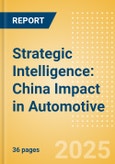Chinese manufacturers have taken over the home market, capturing 60% market share of domestic passenger car sales in 2024. But what is increasingly clear is that China’s auto industry is no longer competing within its borders, as exports surge into Europe, Southeast Asia, and Latin America.
China’s reach in automotive expands well beyond its borders
China has established itself as the largest automotive market, surpassing the US in vehicle sales in 2009 and Japan in vehicle exports in 2023. The analyst projects light vehicle sales in China to exceed 27 million units in 2025, a feat only achieved twice before, in 2016 and 2017. This immense market size has driven demand for a diverse range of vehicles, as international automakers tailor their offerings to meet Chinese consumer preferences. In an unprecedented move, Audi co-developed the E5 Sportback with SAIC Motor without using Audi’s four rings logo, under a distinct China-only marque.Meanwhile, Chinese manufacturers have taken over the home market, capturing 60% market share of domestic passenger car sales in 2024. But even with strong home sales and rising market share, China’s auto industry is undergoing a painful shakeout that will cull weaker plants and marginal EV startups, cut excess capacity and slow near‑term output; the result should be a leaner, more profitable group of OEMs, battery makers and suppliers.
What is increasingly clear is that China’s auto industry is no longer competing within its borders. As exports surge into Europe, Southeast Asia, and Latin America, pressure will mount on foreign OEMs not only to cut costs but also to adapt to Chinese-driven standards in areas like EV architecture and shorter development cycles. This global diffusion of China’s manufacturing model underscores that the competitive battle is no longer confined to market share in China, but to the future structure of the automotive industry worldwide.
Key Highlights
- China’s impact in the automotive industry stretches across vehicle manufacturing, supply chains, electrification and batteries, and emerging automotive technology, including autonomous vehicles and software-defined vehicles.
- This report covers the key technology, macroeconomic and regulatory trends around the topic and dives into deeper industry analysis of China's domestic market forecast, global forecast for Chinese car brands, regional expansion of Chinese car brands, overcapacity, localization outside of China and China's lead in the automonous vehicle theme.
Scope
This report offers a comprehensive analysis of China's Impact on the automotive industry including:
- A technology briefing
- Technology, macroecnomic, and regulatory trends
- Leading companies in the China Impact theme
- Industry analysis and forecasts
- A thematic scorecard ranking companies in the China Impact theme
Reasons to Buy
- As China's impact on the automotive industry continues to develop, several compelling reasons emerge for stakeholders to invest in this dynamic sector.
- This report is essential reading for senior executives as it outlines key trends and strategies that can help businesses navigate the evolving landscape of China's automotive impact and capitalize on emerging opportunities.
Table of Contents
- Executive Summary
- Thematic briefing
- Players
- Trends
- Industry Analysis
- Companies
- Sector Scorecard
- Glossary
- Further Reading
- Thematic Research Methodology
- About the Analyst
- Contact the Publisher
Table 1, p.6: Players
Table 2, p.7-9: Technology trends
Table 3, p.10-12: Macroeconomic trends
Table 4, p.13: Regulatory trends
Table 5, p.14-19: Industry Analysis
Table 6, p.20: Timeline
Table 7, p.21-26: Companies
Table 8, p.27: Future Mobility sector scorecard companies screen
Table 9, p.28: Future Mobility sector scorecard thematic screen
Table 10, p.29: Future Mobilityg sector scorecard valuation screen
Table 11, p.30: Future Mobility sector scorecard risk screen
Table 12, p.31: Glossary
Table 13, p.32: Further reading
Companies Mentioned (Partial List)
A selection of companies mentioned in this report includes, but is not limited to:
- Alphabet (Waymo)
- Amazon (Zoox)
- Auto X
- BAIC
- Baidu (Apollo Go)
- BMW Group
- BYD
- CATL
- CBAK
- Changan Automobile
- Chery
- DiDi Chuxing
- Envision AESC
- EVE Energy
- Farasis
- Ford
- Geely
- General Motors
- Gotion
- Great Wall
- Honda
- Huawei
- Hyundai Motor
- LG Energy Solution
- Li Auto
- Lishen
- Mercedes-Benz
- Mobileye
- Momenta
- Nissan
- Nvidia
- Panasonic
- Pony.ai
- Renault
- SAIC Motor
- Samsung SDI
- SK Innovation
- Stellantis
- SVOLT
- Tesla
- Toyota
- Volkswagen
- Wayve
- WeRide
- XPeng








